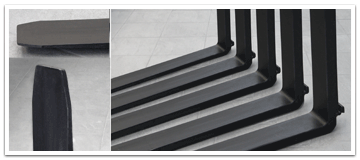Product News
 How To Measure Fork Wear
How To Measure Fork Wear
It is essential that the forks are inspected periodically for any signs of damage such as:
- Surface cracks
- A blade or shank that is not straight
- Fork angle from blade to shank is not straight
- Difference in height of fork tips
- Positioning lock not in working order
- Wear on the fork’s blade or shank
- Wear on the fork’s hooks
- Fork markings not legible
Inspection
Always inspect forks during the pre-operation inspection. This can be easily done using a fork caliper. Forks are constantly subjected to abrasion by concrete floors, steel shelving, etc. If 10% of the original fork thickness has been worn, the fork has to be taken out of service (a 10% reduction in fork blade thickness results in a capacity reduction of 20%).
In addition, every 6 months, a more thorough test should be performed using a magnetic particle or dye penetrant kit to detect cracks on the fork’s surface.
| Part # |
Description |
| SY41800 |
Fork Caliper |
| SY41950 |
Stress Crack Detection Kit |
| SY41950-A |
Cleaner for Detection Kit |
| SY41950-B |
Developer for Detection Kit |
| SY41950-C |
Penetrant for Detection Kit |
Recommendations
Do not operate the forklift if the forks show any of the defects
listed above.
Do not operate a forklift from which the positioning lock has been removed or is inoperable. As the forklift travels, the positioning lock holds the forks in position and prevents sliding of the forks and loss of the load.
Do not overload the forks. Operators should be aware of the capacity of the forklift and the capacity of the forks. Overloading may bend and weaken forks.
Do not repair or modify your own forks. No one but the fork manufacturer should undertake the repair of forks and any modification to the forks must be authorized in writing by the manufacturer.
Repair or replace the forks if they are not in good working order. When you are ordering or reordering forks make sure to get high quality forks that will do your specific lifting jobs safely (considering the materials being handled, weight capacity, for spark-free areas, etc.).
For more information, please contact your sales representative